|
|
|
Sort Order |
|
|
|
Items / Page
|
|
|
|
|
|
|
| Srl | Item |
| 1 |
ID:
177798
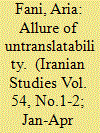

|
|
|
|
|
| Summary/Abstract |
How could one translate into any European language a Persian poem as culturally and aesthetically embedded as this hemistich by Hāfez: beh may sajjādeh rangin kon garat pir-e moghān guyad. This is the central question Mohammad-Rezā Shafiʿi-Kadkani addresses in his essay titled “On Poetic Untranslatability.” For Shafiʿi, translation is primarily a function of cultural—and not linguistic—affinity. Therefore, he argues that Hāfez’s poem is all but untranslatable in European languages given their fundamental cultural difference from Persian. This article critically engages Shafiʿi’s essay by outlining and analyzing the set of problematic assumptions embedded in its rubric of untranslatability. It places Shafiʿi’s view on translation in conversation with theorists of untranslatability in comparative literature and translation studies. Ultimately, it outlines why untranslatability is not a useful conceptual framework for the analysis of linguistic and cultural difference.
|
|
|
|
|
|
|
|
|
|
|
|
|
|
|
|
| 2 |
ID:
085333
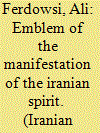

|
|
|
|
|
| Publication |
2008.
|
| Summary/Abstract |
This is a study of the national sacralization of Hafiz as the "emblem of the manifestation of the Iranian spirit." This sacralization began with E. G. Browne in 1902 but reached its definitive formulation in Abd al-Hosein Hazhir's monograph Hafiz-tashrih in 1928. For a nation to have a purchase on itself it must provide for a convocational experience. Shortly after the 1906 Constitutional Revolution, an ascending intellectual elite in Iran set out to do just that by fashioning a heterodox cult of the veneration of Persian poetry by recasting pre-modern texts, authors and their tombs into a national scripture authored by national prophets buried in sacred grounds which culminated in Hafiz as the "seal of its prophets."
|
|
|
|
|
|
|
|
|
|
|
|
|
|
|
|
| 3 |
ID:
162783
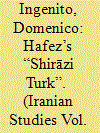

|
|
|
|
|
| Summary/Abstract |
This article constitutes a preliminary attempt to explore the geographical dimension of premodern Persian lyric poetry from the perspective of the relationship between the historical adherence of a text to external reality and the rhetorics of intertextuality and performativity. The pretext for this exploration is the poem known as “Tork-e Shirazi” or “The Turk from Shiraz,” one of the most celebrated ghazals of Hafez of Shiraz. The analysis focuses in particular on the first two lines of the ghazal, whose rich and ambiguous imagery has challenged the community of readers, interpreters, and scholars for centuries. On the basis of historiographical, formalist, and poststructuralist approaches to the study of lyric poetry, the article outlines a generative paradigm that analyzes a given text from the perspective of its abstract, genre-specific, conventionally negotiated, and referential levels of meaning. The contribution of geocritical studies will be combined with rhetorical analysis to conceive of Hafez’s text as a geopoetic map in which the cities of Shiraz, Samarkand, and Bukhara are put in conversation with the mental and historical representations of Iran and India between the thirteenth and fourteenth centuries, during the transition from the Mongol to the Timurid models and ideals of power.
|
|
|
|
|
|
|
|
|
|
|
|
|
|
|
|
| 4 |
ID:
180034
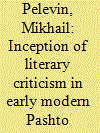

|
|
|
|
|
| Summary/Abstract |
The article overviews the earliest Pashto texts, mostly poetic, in which the incipient forms of literary criticism can be traced as authorial self-reflections related in Persian classics to the self-praise genre (fakhriyya) and explanations of reasons for composing works (sabab-i taʾlīf). Under close examination are the seventeenth century verses of the poets affiliated with the Roshānī religious community and the writings of Khushḥāl Khān Khaṫak (d. 1689). Analyzed texts prove that through the rudimentary discourse on a variety of literary criticism topics, Pashtun authors of early modern times declared and justified the presence of emerging literature in Pashto within the Persophone cultural space of Mughal India, articulating simultaneously their commitment to the proliferation of literacy and Islamic book culture among their countrymen.
|
|
|
|
|
|
|
|
|
|
|
|
|
|
|
|
| 5 |
ID:
127784
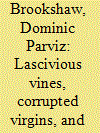

|
|
|
|
|
| Publication |
2014.
|
| Summary/Abstract |
The Persian wine production myth centers on the relationship between a male vintner and his female vine and her daughters, the grapes. This myth, the earliest extant examples of which are found in qas?das by the Samanid poets R?dak? and Bashsh?r Marghaz? and which was much developed by Man?chihr? and his contemporary Farrukh?, contains images of femininity, the mother-child bond, separation, violence, execution, and ultimate redemption. The grape harvest comes in the late summer and culminates in the Mihrag?n festival, a celebration focused on the grape and grape wine, at which poems containing versions of the wine production myth were recited. The present study maps the evolution of this myth over the span of a century through a close reading of eleven poems with specific reference to variations in narrative structure.
|
|
|
|
|
|
|
|
|
|
|
|
|
|
|
|
| 6 |
ID:
180016
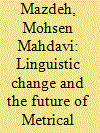

|
|
|
|
|
| Summary/Abstract |
The metrical requirements of Persian poetry are highly restrictive. Traditionally, the rigidity of the metrical system was compensated for by a high degree of flexibility in the poetic language in terms of lexicon, phonology, and morpho-syntax. Using statistical data from different periods of Persian poetry, this paper argues that the degree of flexibility of the language used in metrical Persian poetry has been in constant decrease, moving towards what may potentially be a language crisis for metrical Persian poetry. This study traces the linguistic and meta-linguistic origins of the initial flexibility of the poetic language and its subsequent change, suggesting that some of the recent trends in Persian poetry may be viewed in part as reactions to this potential crisis.
|
|
|
|
|
|
|
|
|
|
|
|
|
|
|
|
| 7 |
ID:
184815
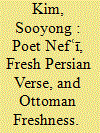

|
|
|
|
|
| Summary/Abstract |
Scholars have generally recognized the Ottoman poet Nefʿī (d. 1635) for his refinement of the panegyric in Turkish and his skill in its unflattering twin, the invective. They have thus paid little attention to the fact that he composed poems in Persian, and sufficient to compile a collection of them, simply viewing his output as a byproduct of his taste for the fresh style emanating from the East, particularly India, with no consideration of other factors at play. The article addresses this contextual gap by situating Nefʿī's engagement with the fresh style in relation to wider efforts at poetic renewal and also to literati disputes about the extent to which the fresh style and other currents from the East ought to be adopted and assimilated, in which differing formal and generic preferences, as well as linguistic and rhetorical concerns, were central. The article ultimately suggests that Nefʿī's overall work should be seen as part of those wider efforts that also aimed at making Ottoman practice distinctively fresh.
|
|
|
|
|
|
|
|
|
|
|
|
|
|
|
|
| 8 |
ID:
154106
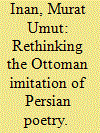

|
|
|
|
|
| Summary/Abstract |
This article revisits the common discourse that Ottoman poetry is a derivative imitation of Persian poetry. I begin by surveying and discussing the discourse of imitation that has pervaded approaches to Ottoman poetry in particular and Ottoman literature in general. Then I turn to explore how Ottoman poets engaged with Persian poetry by focusing on a lyric poem composed by the Ottoman sultan Süleyman the Magnificent (1494‒1566) in imitation of the Persian master poet Hafiz of Shiraz (ca. 1315‒90). In light of intertextual analysis, I illustrate and discuss the intricate ways in which Süleyman models himself on Hafiz in crafting his poem. I conclude with the idea that a closer analytical look at Ottoman poets’ intertextual dialogue with Persian poetry can offer better insights into the Ottoman reception of Persian poetic models as well as into the meaning and workings of imitation in the Ottoman literary context.
|
|
|
|
|
|
|
|
|
|
|
|
|
|
|
|
| 9 |
ID:
127783
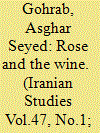

|
|
|
|
|
| Publication |
2014.
|
| Summary/Abstract |
As everyone knows, alcoholic drinks, including wine, are forbidden by Islam. Readers of Persian poetry often wonder how is it possible that Persian wine literature is one of the richest in the world and whether the poets and authors ever address the illicitness of the wine in their works. This article examines how one author, Zang? Bukh?r?, presents a catalogue of positive and negative qualities of wine in his Gul u mul ("The Rose and the Wine"). Through the genre of debate (mun?zara), he shows how a courtly audience may have tried to justify the drinking of wine. The article examines the formal generic characteristics of such debates, showing how the form of the debate is rather appropriate to let forbidden objects or ideas, in this case the wine, speak for themselves thus defending their position in an Islamic society. entertaining in is richness in metaphors and imagery used by the wine and the rose to voice their superiority to each other, but it also addresses a rather controversial topic in an uncontroversial style.
|
|
|
|
|
|
|
|
|
|
|
|
|
|
|
|
| 10 |
ID:
127785
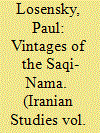

|
|
|
|
|
| Publication |
2014.
|
| Summary/Abstract |
Drawing on a rich tradition of anacreontic poetry and taking inspiration from works by Niz?m? and H?fiz, the s?q?-n?ma or "cupbearer's song" emerged as an independent genre in the early sixteenth century and flourished throughout the Persian literary world for the next 250 years. Looking back on the development of the genre, the early seventeenth-century literary historians 'Abd al-Nab? Qazv?n? and Awhad? Baly?n? give contrasting accounts of its formation, but both agree on the significance of the work of Hak?m Partuv? Sh?r?z? (d. 928/1520-21). An examination of his s?q?-n?ma, together with two other early representatives of the genre by Sidq? Astar?b?d? (d. 952/1545) and Sharaf Jah?n Qazv?n? (d. 968/1561), shows how closely this new genre was tied to the politics and ideology of the new Safavid state and reveals profound structural similarities to the preeminent panegyric genre of the Islamicate world, the qas?da. But once the basic components of the s?q?-n?m? were distilled and taken up by poets outside this socio-political environment, the genre proved to be as protean as the wine symbolism at its core. Cupbearer songs from the end of the century, particularly those of Muhammad S?f? M?zandar?n? (d. 1035/1625-26) and Sanjar K?sh?n? (d. 1021/1612), show how the basic elements of the genre could be reconfigured to serve a variety of more personal interests.
|
|
|
|
|
|
|
|
|
|
|
|
|
|
|
|
| 11 |
ID:
160286
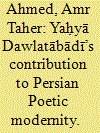

|
|
|
|
|
| Summary/Abstract |
In 1912, Yaḥyā Dawlatābādī composed two poems, the form of which diverged greatly from the canonical rules of tradition. Both poems were based on syllabic meters. Critics and historians of modern Persian literature have given these poems little consideration, and discussed them merely from the point of view of metrics. When compared to the great modernist endeavors in the poetry of the time, these pieces were judged severely, or altogether disavowed. This paper aims to show that, beyond mere metrical audacity, Yaḥyā Dawlatābādī’s syllabic poems were in fact innovative. As the article argues, they were born out of the same quest for fresh poetic forms that induced contemporaneous modernists to create new, individualized poetic patterns.
|
|
|
|
|
|
|
|
|
|
|
|
|
|
|
|
|
|
|
|
|